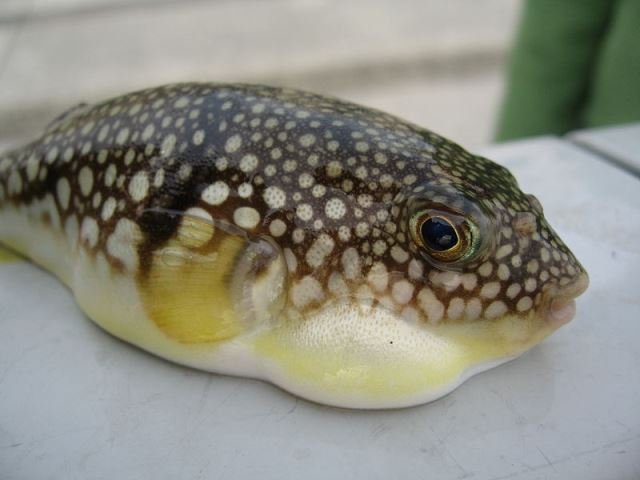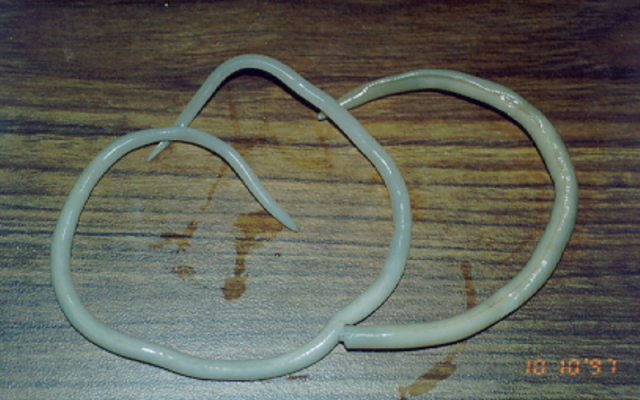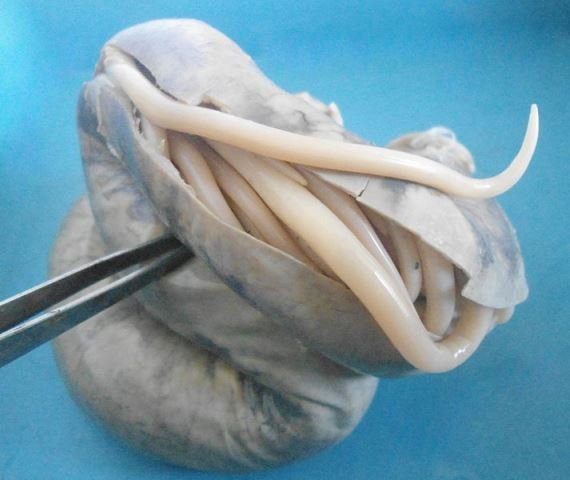The BoxJellyfish, The PufferFish and The Ascaris Roundworm (The Baddest Animals Pt-3)
Today I'd be talking about the final three animals and concluding the series on "the baddest and most poisonous animals around us".
Incase you missed the first two parts, especially about the animals in question, well, you can read up on the part-1 and the part-2 through the links attached.
A lot of people like myself love to travel and venture into the wild in the form of admiration of the relief and aesthetics given to us by nature.
However, from the studies related to the animals in these series, it is one thing to admire the fauna around us; but doing so at risk to your safety and health could be disastrous, especially if you encounter any of these animals during such a vacation, tour or exploration.
Caution should be key; most especially, when you are eager for dive into any admirable or enchanting water body. A good example of cautions which we should always adhere to when visiting unfamiliar terrains for the first time can be similar to that found in the photo below.

Neglecting such caution signs, could be hazardous to ones health and safety to say the least. Well, today we are considering the Box Jellyfish, the Pufferfish and the Ascaris Roundworm.
1.) Chironex fleckeri (Box Jellyfish – also known as Sea Wasp)
Known as the most lethal jellyfish in the world, this bad guy was responsible for the deaths of 63 people from 1886 to 1996 in Australia. According to a poison specialist Dr. Bryan Fry, the C. fleckeri (Box Jellyfish) is the sole proprietor of the most painful poison on earth.
How it attacks (Behaviour)
This jellyfish is painfully bad on some serious level. First of all, its tentacles which are up to 3m (10 ft) in length are covered in millions of Cnidocyte. Now, when a person (who, unfortunately, has been sentenced by nemesis or karma to have a really bad and shitty day) gets stung via the tentacles of the boxjellyfish, microscopic darts are released, and they have one job responsibility – to deliver extremely powerful venom. ref-1, ref-2
Each sting results in excruciating pain and an untreated victim may die in two to five minutes, especially if the sting occurs in a significant area. Also, it is reported that the venom present in one of these Box Jellyfish is potent enough to kill 60 adult persons.
However, in most cases, stings do not require a trip to a doctor, but when the Jellyfish decides to hug you with its tentacles, the feeling isn’t romantic at all (true story), instead it feels like your body is being wiped and massaged with acid, or a severe burning sensation as if you are being branded with a red hot iron, and the pains generated from the “hug-sting” remains and doesn’t leave for several weeks.
Where are these species endemic?
This Chironex Fleckeri is endemic in coastal waters around the northern parts of Australia, especially during summer, and New Guinea. Also they are present in the waters northward to the Philippines and Vietnam.
For treatment?
Vinegar is mostly recommended; as it is about 4 – 6% dilute acetic acid, and it is capable of deactivating nematocysts which are undischarged and further preventing them from opening and releasing venom. ref-3
2.) Tetraodontidae (Pufferfish)
In a lot of cases, most animals and organisms attack, hurt or kill humans when alive. It is not every other day that one gets to hear that a dead animal is still killing humans (Yea, you heard that right).
The pufferfish is such a weirdo. This strange fish is somewhat of a “pure-evil”. When it dies is when it is even more deadly, because if it isn’t cooked properly, whoever is going to be feasting on it is simply ingesting pure poison. This is the case because in most species of the fish, its organ such as the liver and their skin contain tetrodotoxin, and are extremely toxic to most animals that prey on them. ref-4
It is however considered a delicacy in parts of Asia – Japan, Korea, and China, only when it is prepared by seasoned chefs who have been specially trained and know the unsafe parts of the fish and quantity to get rid of.
Where they can be found
They are mostly found in the tropical regions of the world. They can grow to length to over 100cm (39 inches). They are not present in cold waters, and are relatively scarce in temperate zones. They can inhabit marine/brackish waters and some species can enter fresh water (about 35 species out of the 191 species of the genera). The species which are found in fresh waters are located around tropical regions of South America, Africa, Southeast Asia and Australia ref-5.
Effects of poorly prepared pufferfish on humans
Pufferfish poses several fatal risks on humans if not prepared properly for consumption. It can lead to death, deadening of the tongue and lips, and numbness. It can induce vomiting, prickling of the skin, rapid increase in heart rate, drop in blood pressure, dizziness and muscle paralysis. The toxin in the fish, when eaten, can paralyse the muscle of the diaphragm causing the victim to stop breathing. People who suffer the effect of the poison after 24hours stand a chance of survival, howbeit after being in a coma for several days (Just for eating a fish? Nah! I think, for this fish, I’d pass).
3.) Ascaris lumbricoides (Ascaris Roundworm)
This slimy sucker can grow to 35 cm (14 inches) and are the common types of parasitic worms in humans. It is responsible for the “ascariasis disease”. It is estimated that roughly one-sixth of the human population is infected by the Ascaris lumbricoides or similar species. ref-6
Where it is found
Well, I guess since it is a worm it should not be too surprising to find out that this thin parasite can be found in worldwide particularly in tropical and subtropical regions of the planet.
Infection and Strange Behaviour of this worm
This roundworm infects humans through ingestion of its fertilized eggs. After it finds it way inside the body, the fertilized egg eventually matures and becomes a larva worm and proceeds into the blood stream and in most cases settle in the lungs (you can now imagine the rest of its dastardly act from there).
Once in the bloodstream is gets carried to the liver and heart and eventually finds its way in the alveoli where is grows further before molting.
Within 3 weeks, the larva matures into an adult or female worm, where fertilization can now occur in the female. (Imagine all of this happening within your gorgeous body… 😖
You know the scary part? The female A. lumbricodes can produce as much as 200,000 eggs per day for a period of 12 – 18 months (Holy Spencer!! 😨). Now while this unfortunately population drive is taking place within a victim’s body, the fertilized eggs become infectious within a few weeks.
Its scary behaviour doesn’t end there; the eggs develop a lipid layer which is capable of resisting acids, alkalis and other chemicals, making this very worm or nematode to be somewhat of an Omni-present parasite [ref-7 (Text)(Journal)]. When they find their way to the soil they can stay active for around 10 years.
Conclusion
The Boxjellyfish and Pufferfish are mainly encountered in marine environments. It always advised that caution signs and prohibitions in areas having abundant water bodies should be strictly adhered, in order to avoid ugly and risky situations such as diving or dipping into infested water bodies thereby leading to stings from both species of aquatic animals.
The Ascaris lumbricoides on the other hand is a very nasty parasite which already has a knack for being abundant where sanitation of all levels is poor and where the practice of using raw human faeces as fertilizer thrives. Studies have shown that these tiny nematodes inhabit the body of people and the victims do not even realize that they are hosting them. As tiny as they may be, these parasites kill about 4,500 people every year ref-8.
REFERENCES
boxjellyfish | aims.gov.au | ncbi.nlm.nih.gov | sciencedirect | chironex fleckeri | animaldiversity.org | fishesofaustralia | tetraodontidae | sciencealert | ascaris lumbricoides | plos.org
Thank you for your time and for reading.
If you found this post interesting, then kindly UPVOTE, RESTEEM and FOLLOW @rickie, for more.





I've eaten pufferfish on two occasions out in Japan - with no adverse side effects ( :D ). An expensive delicacy which otherwise wasn't all that memorable. Whilst I'm pretty sure no-one eats box jellyfish, I know out in Japan I also sampled the tentacles of a less sinister related species. The texture was memorable in that they were kind of crunchy (if something so soft and delicate can ever be described that way). I would highly recommend for the texture if for no other reason. Taste-wise, I'm pretty sure these too were fairly unremarkable, deriving most of the flavour of the dish from the 'juice' (???) they were served in. Probably vinegar based and fairly watery but it might have been something like mirin???
Hopefully, I'll never have eaten a nematode but I've certainly had to study them in the past.
Good post! And you only live once, eh? :)
Wow! You pretty much seem like a much experienced adventurer than I am @zool237. You've eaten the pufferfish and lived to tell the tale, eh? Your dish must have been made by an experienced cook. Thanks for dropping by and sharing you sea-food experience too @zool237
Just thinking of those roundworms in me gives me the creeps. I'd rather swim in a pool of jellyfish.
Lolz.....You must have an "anti-jellyfish sting" then @tking77798. Yea, the idea of roundworms inside the body is pure evil, I dare say. Thanks for reading.
Hello! I find your post valuable for the wafrica community! Thanks for the great post! @wafrica is now following you! ALWAYs follow @wafrica and use the wafrica tag!
Hmm, I must confess I was educated. So roundworm is even among deadliest animals in the world
Yea, it is @tobex. The human body suffers a great deal following the ingestion of the dreaded nematode.
Hmm
So a good amount of the world populace has worms...
Enlightening
Yea, strange as that sounds....Its true @lawkay. Thanks for reading
That box jellyfish looks like a creature from hell. I can't even imagine how the sting would look like.
Nice piece man
I agree with you @samminator...creature from hell indeed. The imagination would even be painful...lolz
WHOA!!! I had no idea that human roundworms got that big! That's kind of scary!
Also, Australia use to be the number one place that I wanted to visit in the world, despite all of the venomous snakes and spiders. It was the box jelly that changed my mind. Some of those things can be the size of a thumbnail and still kill you. NOPE! NOPE! NOPE!
Hahahaha! Yea, as tiny as they are, they could be wickedly devastating when they strike. You could still make it to Australia @sustainablyyours, just try staying away from the coastal areas though for obvious reasons. Thanks for reading.
I fear the pufferfish the most, it is really surprising to know an animal is still deadly after death. Thanks for sharing this.
Thats why sometimes I prefer to be on land. The creatures lurking on the waters specially the box jellyfish and the pufferfish seriously freaks me out. The roundworms are also very gross. Awesome article @rickie, I can see that you are also very responsive on comments on your posts.Keep it up!
